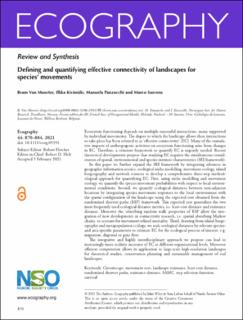| dc.description.abstract | Ecosystem functioning depends on multiple successful interactions, many supported by individual movements. The degree to which the landscape allows these interactions to take place has been referred to as ‘effective connectivity’ (EC). Many of the cumulative impacts of anthropogenic activities on ecosystem functioning arise from changes in EC. Therefore, a coherent framework to quantify EC is urgently needed. Recent theoretical developments propose that studying EC requires the simultaneous consideration of spatial, environmental and species intrinsic characteristics (SEI framework). In this paper we further expand the SEI framework by integrating advances in geographic information science, ecological niche modelling, movement ecology, island biogeography and network sciences to develop a comprehensive three-step methodological approach for quantifying EC. First, using niche modelling and movement ecology, we quantify the species movement probabilities with respect to local environmental conditions. Second, we quantify ecological distances between non-adjacent locations by integrating species movement responses to the local environment with the spatial configuration of the landscape using the expected cost obtained from the randomized shortest paths (RSP) framework. This expected cost generalizes the two most frequently used ecological distance metrics, i.e. least-cost distance and resistance distance. Moreover the ‘absorbing random walk’ properties of RSP allow the integration of new developments in connectivity research, i.e. spatial absorbing Markov chains, to account for movement-related mortality. Third, drawing from island biogeography and metapopulation ecology, we scale ecological distances by relevant speciesand area-specific parameters to estimate EC for the ecological process of interest, e.g. migration, dispersal or gene flow. The integrative and highly interdisciplinary approach we propose can lead to increasingly more realistic measures of EC at different organizational levels. Moreover efficient computation allows its application to large-scale high-resolution landscapes for theoretical studies, conservation planning and sustainable management of real landscapes. Circuitscape, movement cost, landscape resistance, least-cost distance, randomized shortest paths, resistance distance, SAMC, step selection function, survival | en_US |

